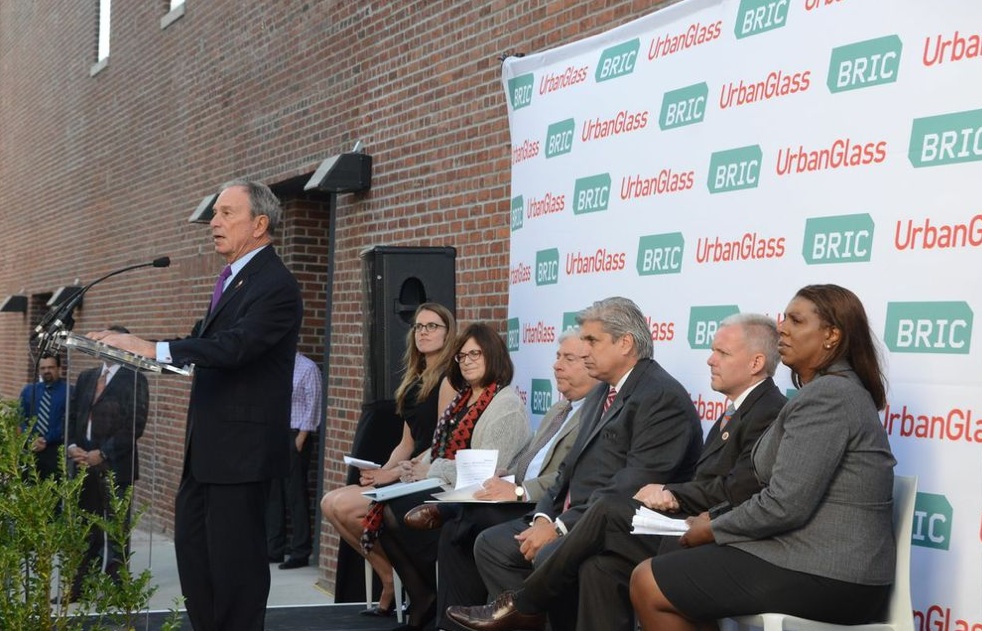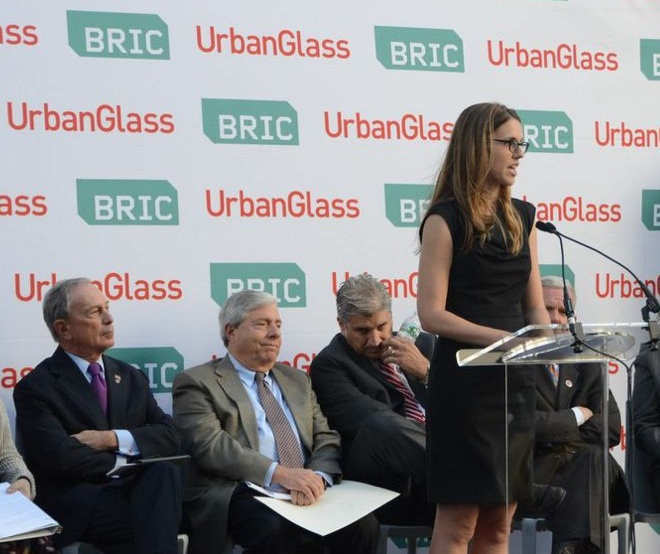With the ceremonial breaking of a glass ribbon, New York City Mayor Michael Bloomberg officially reopened the expanded and improved UrbanGlass facility in Downtown Brooklyn on the morning of Wednesday, October 2, 2013. A large crowd of friends and supporters of UrbanGlass (and its neighbor BRIC Arts) gathered on a windy fall morning to hear the mayor, Brooklyn Borough president Marty Markowitz, and other elected officials talk about the transformative power of the arts. The former Strand Theater building that has housed UrbanGlass since the early 1990s, has undergone a two-year, multi-million dollar renovation that has upgraded and expanded the facilities, gallery, and retail spaces.
 “With today’s glass cutting, UrbanGlass and BRIC are set to embark on a new exciting future, both for the artists and the communities that they serve and for the audiences their expanded facilities are sure to serve,” said Mayor Bloomberg. “UrbanGlass, which is the largest studio in the nation dedicated to glassmaking, has a new state-of-the-art glassworking facility, perhaps the very best in the world, and new classrooms as well. You should see it, it is really spectacular. For the first time they will also have a street-level presence for exhibitions including the inaugural ‘A Tree Grows’ by Kathy Gray, and a retail space where artists can sell their works.”
“With today’s glass cutting, UrbanGlass and BRIC are set to embark on a new exciting future, both for the artists and the communities that they serve and for the audiences their expanded facilities are sure to serve,” said Mayor Bloomberg. “UrbanGlass, which is the largest studio in the nation dedicated to glassmaking, has a new state-of-the-art glassworking facility, perhaps the very best in the world, and new classrooms as well. You should see it, it is really spectacular. For the first time they will also have a street-level presence for exhibitions including the inaugural ‘A Tree Grows’ by Kathy Gray, and a retail space where artists can sell their works.”
“With the reopening of this building, we are thrilled to welcome back our artists, students, and community at large,” said UrbanGlass executive director Cybele Maylone. “UrbanGlass is a vibrant studio facility for artists from around the world wishing to create with glass, an education center, and an exhibition space. Now, with the establishment of our first floor, we will be able to invite the public in in a much bigger and broader way.”
“None of this would have been possible without the support of the many people and institutions who were critical to making the new UrbanGlass a reality,” Maylone continued. “The City of New York has been an extraordinary partner. Their commitment to our project confirms the central role that UrbanGlass plays in the cultural landscape of New York City. We also extend a special thank you to the Borough of Brooklyn, which was championing this project from the start. We are also incredibly grateful for the tremendous support of the Agnes Varis Trust, whose leadership gift has been one of the cornerstones of our campaign. This morning we are proud to open the Agnes Varis Art Center, named in honor of Agnes Varis, scientist and philanthropist, who was raised and studied in Brooklyn. … We are also grateful to Corning, Inc., Tiffany & Co., and the many individuals who have come together to make this project possible”
 “On a personal note,” Maylone concluded, “I have only been with UrbanGlass for about six months. So this project is really the result of the extraordinary vision of UrbanGlass’s board of directors, many of whom are here today. UrbanGlass is blessed with a board whose dedication to this project has been essential. Their commitment along with that of our staff has been the driving force behind making what you see today possible.”
“On a personal note,” Maylone concluded, “I have only been with UrbanGlass for about six months. So this project is really the result of the extraordinary vision of UrbanGlass’s board of directors, many of whom are here today. UrbanGlass is blessed with a board whose dedication to this project has been essential. Their commitment along with that of our staff has been the driving force behind making what you see today possible.”
After the glass ribbon was broken with a deft stroke of a hammer by Mayor Bloomberg, sporting safety goggles, there was a breakfast reception and tours of the new facility.
That same evening, many of the board members and special guests of UrbanGlass returned for an evening of more speeches, reunions with old friends, and demonstrations of the brand-new Wet Dog-designed hot shop facility where UrbanGlass-affiliated artists blew a molten bottle which was filled with water, capped off, and then broke, much like a champagne bottle on the prow of a new ship.
Like a cruise ship sailing into the night, the UrbanGlass facility journeyed on into its first evening of operation, the exterior lit by neon tubing, its street-level retail space and gallery beckoning local residents through its doors, possibly to embark on their own individual journey to the world of glass.


